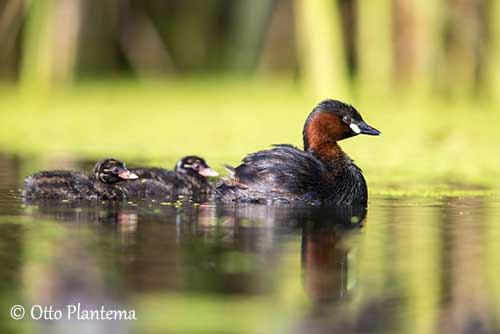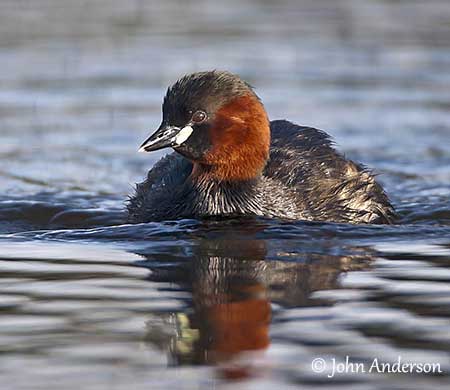
Fr: Grèbe castagneux
Ang: Little Grebe
All: Zwergtaucher
Esp: Zampullín Común
Ita: Tuffetto
Nd: Dodaars
Sd: smådopping
Photographers:
John Anderson
John Anderson Photo Galleries
Didier Buysse
Vision d’Oiseaux
Steve Garvie
RAINBIRDER Photo galleries & Flickr Rainbirder
Jean-Claude Jamoulle
A la rencontre des Oiseaux
Otto Plantema
Trips around the world
Ingo Waschkies
Bird Photography
Nicole Bouglouan
Photographic Ramble
Text by Nicole Bouglouan
Sources:
HANDBOOK OF THE BIRDS OF THE WORLD vol 1 by Josep del Hoyo-Andrew Elliot-Jordi Sargatal - Lynx Edicions - ISBN: 8487334105
THE COMPLETE BOOK OF BRITISH BIRDS – Written by “Royal Society for the Protection of Birds” experts - Préface de Magnus Magnusson - Michael Cady- Rob Hume Editors - ISBN: 0749509112
Javier Blasco-Zumeta & Gerd-Michael Heinze – Little Grebe
Birds in Cheshire and Wirral - Little Grebe (Tachybaptus ruficollis)
Breeding biology of the Little Grebe Tachybaptus ruficollis in Britain and Ireland
THE SEXUAL DISPLAY OF THE LITTLE GREBE
BIRD ECOLOGY STUDY GROUP - BESG - Courtship ritual of the Little Grebe
Birds of Britain - The Web Magazine for Birdwatchers
Wikipedia, the free encyclopaedia
Little Grebe
Tachybaptus ruficollis
Podicipediformes Order – Podicipedidae Family
INTRODUCTION:
The Little Grebe is the smallest European member of the family Podicipedidae. It is rounder and dumpier than congeners, but it is able to transform to a sleek, well developed hunter beneath the water surface. All morphological features allow fast movement underwater, and especially the legs placed well back on the body, and the powerful, lobbed feet. This species is a very good diver and swimmer.
The Little Grebe has seven subspecies sharing a very large range across Europe, much of Asia down to New Guinea, and most of Africa.
It breeds solitary in vegetated areas of freshwater lakes. The nest is a floating platform anchored to the aquatic vegetation.
It feeds mainly on insects and larvae, but it also takes crustaceans, molluscs and small amphibians and fish, caught by diving and swimming.
The Little Grebe is described as widespread and common throughout the range. It is not globally threatened and has expanded its range in many areas, following modification of wetland habitats compensated by construction of man-made ponds, dams and reservoirs.

DESCRIPTION OF THE BIRD:
Biometrics:
Length: 25-29 cm
Wingspan: 40-45 cm
Weight: 140-230 g
The Little Grebe in breeding plumage has bright rufous-chestnut sides of head, throat and foreneck, contrasting with blackish-brown crown, hindneck, upperparts and upperwing-coverts. The flight-feathers are brownish-grey with some amount of white on secondaries and at base of inner flight-feathers, forming a large panel on the wing. The white rump is usually fluffy.
The underparts are dark brown from neck to breast and flanks. The underwing-coverts are white and the dark areas are paler than on the upperwing except the dark tertials. The feathers are usually fluffy on the flanks and often show some chestnut and pale buff wash, mostly whitish on belly and tail base. The undertail-coverts are whiter.
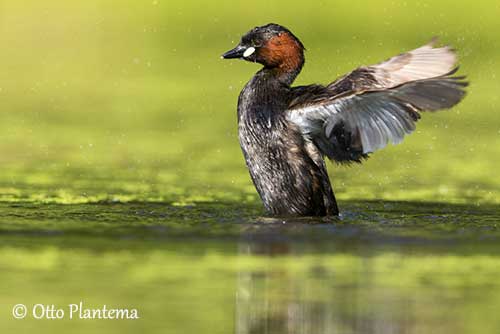
The bill is black with reduced whitish/yellowish tip. There is a conspicuous pale yellow gape-skin at base of the bill. The eyes are dark brown. Legs and lobbed feet are greenish-grey.
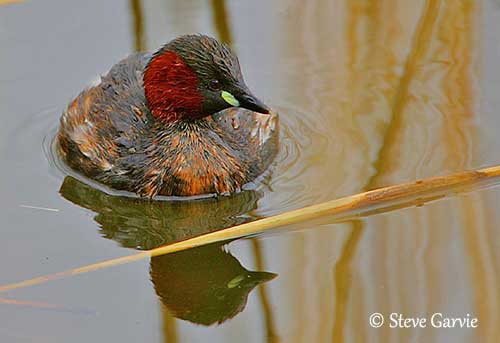
The non-breeding adult is paler with dark grey-brown upperparts. The bright rufous-chestnut areas are mostly buff to ochre brown, whereas chin and throat are whitish. Body sides and flanks are paler too, mostly brownish to pale buff.
The patch at the base of the bill is pale greenish-yellow.
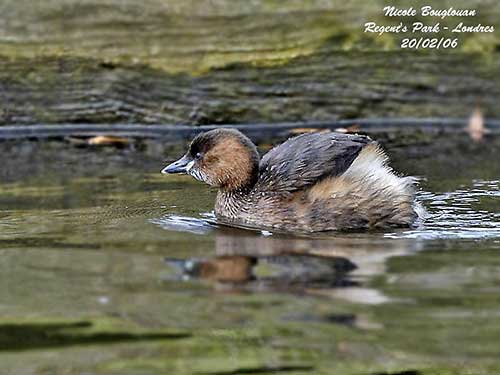
Male and female have similar plumage, but the female is smaller and duller than male.
The juvenile resembles non-breeding adult with some dark markings on the face. The bill is yellowish, becoming progressively dark and finally black in adult plumage
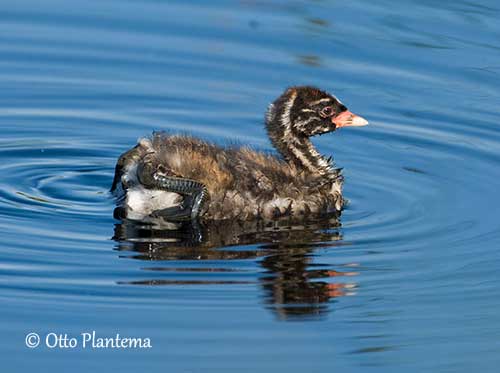
SUBSPECIES AND RANGE:
The Little Grebe has seven subspecies that differ mainly in size, coloration and amount of white on secondaries.
T.r. ruficollis (described above) is found from Europe and W Russia, and S to North Africa.
T.r. albescens breeds in Caucasus, E to Lake Balkhach and Tien Shan. Outside this period, it is present SE to India, Sri Lanka and Myanmar.
T.r. iraquensis is found in SE Irak and SW Iran.
T.r. capensis is found in sub-Saharan Africa, Madagascar, Sri Lanka and Indian Subcontinent, E to Burma.
T.r. poggei occurs from SE to NE Asia, Hainan, Taiwan, Japan and S Kuril Islands.
This race has pale yellow eyes instead of dark brown.
T.r. philippensis is found in N Philippines except Mindanao.
T.r. cotabato occurs in Mindanao in the Philippines.
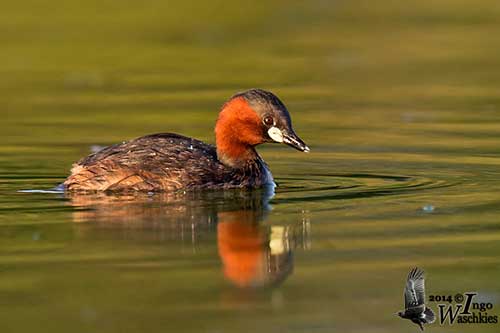
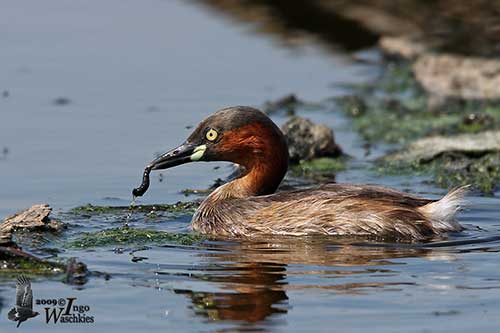
T.r. poggei
With pale eyes
HABITAT:
The Little Grebe frequents a variety of wetlands such as small, shallow lakes and ponds, canals, reservoirs, dams, sheltered bays, and also the vegetation on the shores of large lakes.
Outside breeding season, it is more often observed in open waters, but it is less frequently found on coasts or in protected estuaries. However, it may occasionally appear on the coast in small bays. The species is visible from lowlands to mountains.
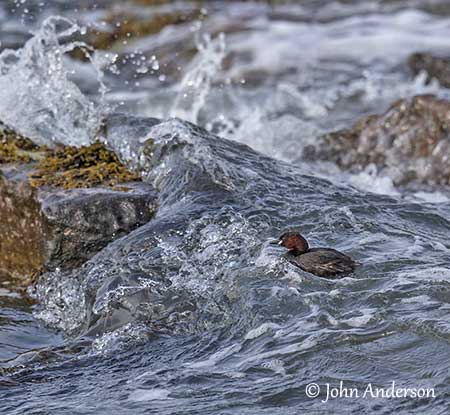
CALLS AND SONGS: SOUNDS BY XENO-CANTO
During the breeding season, the Little Grebe gives a far-carrying, trilled, repeated “weet-weet-weet” or “wee-wee-wee” resembling a horse whinnying. This call is given singly or in duet by both mates.
The alarm call is a harsh “weeeib” and we can also hear a repeated “pit” or “whit”.
BEHAVIOUR IN THE WILD:
The Little Grebe feeds on insects and larvae of several families including Ephemeropterans, Plecoptera, Heteroptera, Coleopterans, Dipterans, Trichoptera, and the larvae of Odonata.
But aquatic prey such as crustaceans, molluscs, young amphibians, small frogs and some small fish are also part of the diet. The fish can reach up to 11 centimetres.
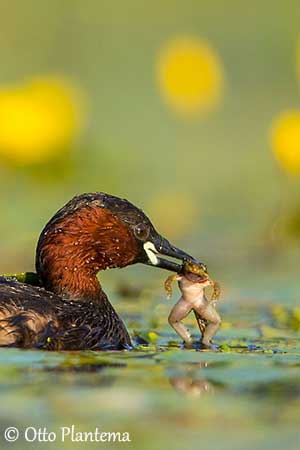
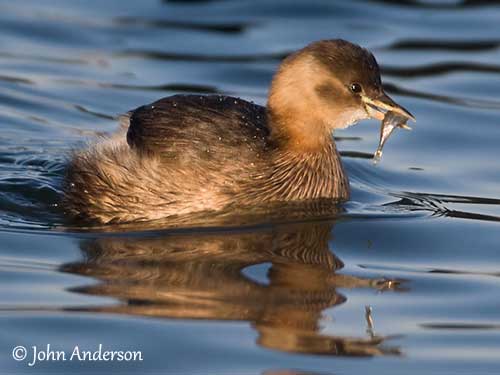
It pursues the prey underwater because it is a very good swimmer and diver. It usually dives for 10-25 seconds to 1 metre depth. It swims with both head and neck submerged. The prey is caught off emergent vegetation or water surface.
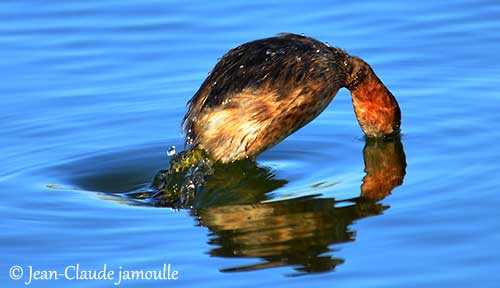
The Little Grebe is a highly developed hunter beneath water. Its morphology allows it fast movements when submerged. The legs are placed well back on the body and the reduced tail does not collide with the lobbed feet.
When underwater, it often appears silver, due to the air bubbles trapped under the feathers. This feature helps to keep it warm and allows it to float to the surface while hunting for diving prey.
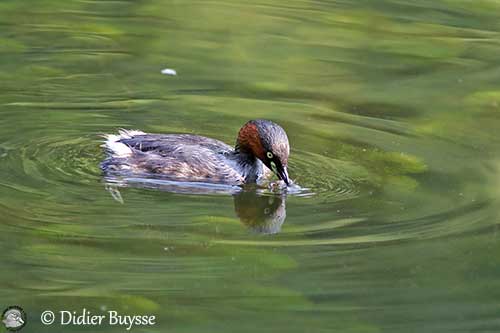
T.r. poggei
With pale eyes
The Little Grebe is monogamous like most grebes. In the genus Tachybaptus, the courtship is more vocal and often with duets by both mates. The individual displays are simple, as this species is small with few ornaments on the plumage except the bright rufous head sides and neck.
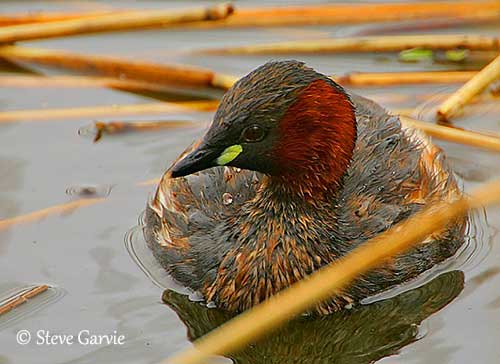
A courtship ritual has been observed in Singapore in April 2010.
Two pairs appeared in two different locations. One member of a pair was swimming away for a short distance before spurting off in a combined “walking and flying” movement on the water, while performing strong wingbeats. Then, it turned around and the same display was again observed, until ending in front of its mate. Both birds were calling loudly during this display. (Samson Tan – Singapore – May 2010). See the sources at the bottom of this page.
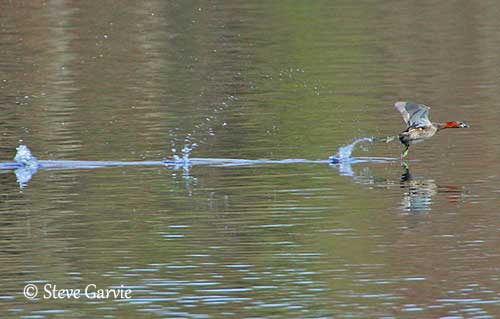
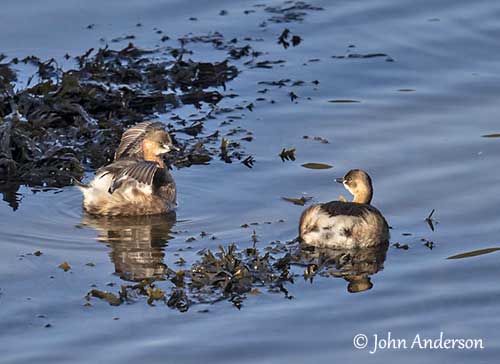
Once the birds have paired up, they exclude other grebes from the area which becomes their breeding territory, defended against intruders.
The Little Grebe nests on a floating platform anchored to the submerged vegetation. Both adults feed and rear the chicks.
Outside breeding season, it moves to spend the winter in more open or coastal waters. It is migratory in the parts of the range where the waters freeze.
This species is resident, dispersive and migratory, according to winter conditions on the breeding grounds. The nominate race has been recorded in N Norway, Azores, Madeira and Canary Islands.
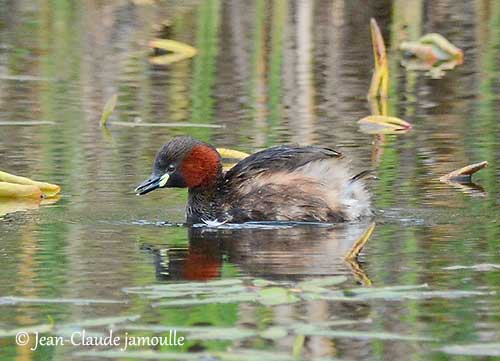
Like other grebes, the Little Grebe rarely flies if alarmed. It prefers to dive and swim underwater, before appearing again a few metres away.
The take-off needs a long running along water surface, while the bird performs rapid wingbeats. Once airborne, it can fly for relatively long distances, allowing the species to colonize new wetlands. The Little Grebe is able to fly over unfavourable habitats and it often explores new areas.
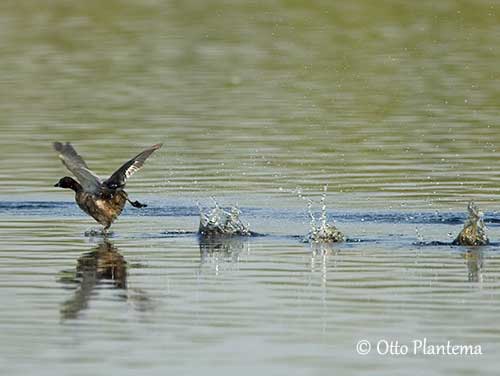
REPRODUCTION OF THIS SPECIES:
The breeding season varies depending on water levels and growth of the emergent vegetation.
In W Palearctic, the breeding period takes place between February and September, with peak in April/July. In Japan, it occurs in May-July, sometimes between October and February. It breeds in all months in tropical Africa and in parts of Sundas.
The nest is placed at water’s edge because the grebe cannot walk easily with the legs set very far back. It is a floating structure made of decaying plant material. It is anchored to aquatic plants or sometimes attached to branches of waterside bushes.
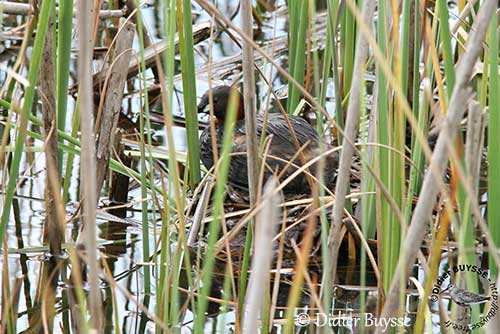
The female lays 3-5 whitish eggs which become stained with the decaying nest material while the incubation is progressing. Both adults share the incubation during 20-25 days.
At hatching, the chicks are covered with dark down with pale stripes, whereas the underparts are paler. They leave the nest and can swim soon after hatching. The adults carry them on their backs, but this practice in less developed than in grebes of genus Podiceps. The nest is often used for resting out of the water. During the first week after hatching, they often remain on the nest with an adult while the other parent brings small food items.
They are independent at 30-40 days and are able to fly within 44-48 days.
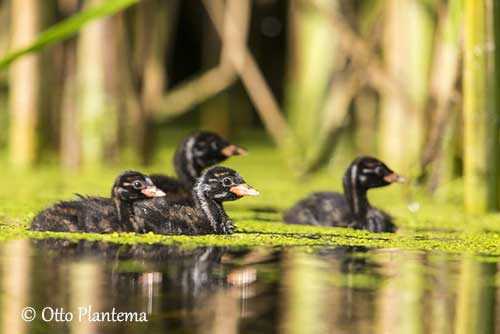
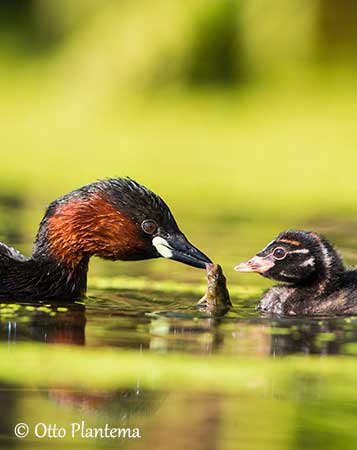
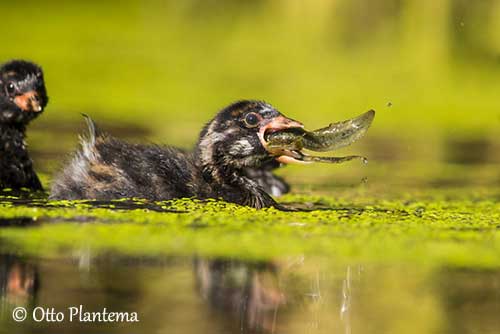
PROTECTION / THREATS / STATUS:
The Little Grebe is described as widespread and common throughout most of the wide range.
But the species is affected by habitat loss, especially destruction of wetlands caused by pollution and recreational use, although construction of man-made reservoirs and dams leads to expansion of this species in numerous areas.
In Europe, the winter conditions may involve fluctuation of the numbers, especially after cold winters.
The Little Grebe is also hunted for commercial and recreational use in Iran.
The global population is estimated to number 610,000/3,500,000 individuals and the trend is decreasing, but some populations are stable whereas others have unknown trends, like in Europe.
But the Little Grebe is not globally threatened and currently evaluated as Least Concern.
